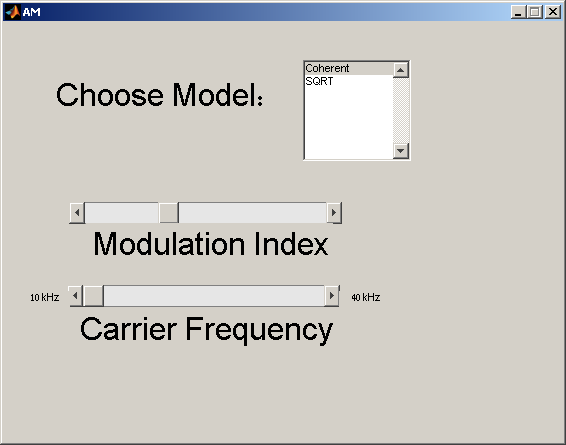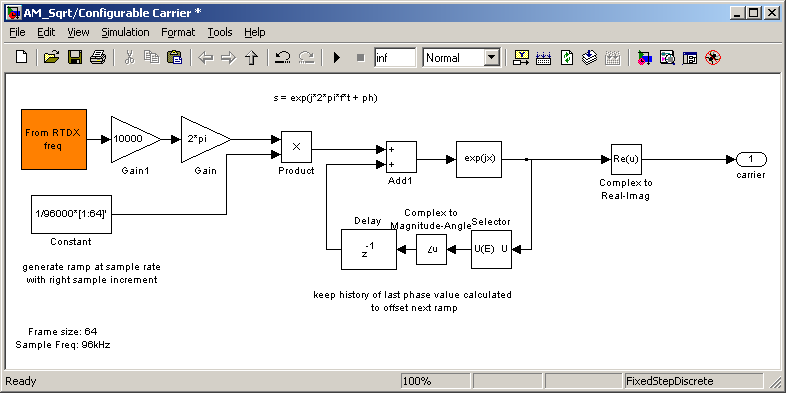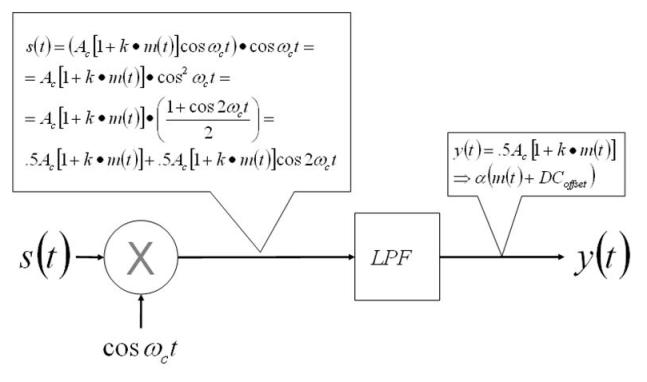| << Chapter < Page | Chapter >> Page > |
In the script we have to perform the following tasks:
The following steps describe this implementation.
function AM_OpeningFcn(hObject, eventdata, handles, varargin)
last_model=1;handles.last_model=last_model;
modelName = gcs;%connect to the board
CCS_Obj = connectToCCS(modelName);% Identify RTDX channel names/modes
chan_struct(1).name = 'InputModulation';chan_struct(1).mode = 'w';
chan_struct(2).name = 'freq';chan_struct(2).mode = 'w';
handles.rtdx_chan1=chan_struct(1);handles.rtdx_chan2=chan_struct(2);
% Identify RTDX host buffer parametersRTDX_config_struct.Buffsize= 32768;
RTDX_config_struct.Nbuffers = 4;RTDX_config_struct.Mode = 'continuous';
%building the full path of the file to be loadedCodegenDir = fullfile(pwd, ['AM_Coherent' '_c6000_rtw']);OutFile = fullfile(CodegenDir, ['AM_Coherent' '.out']);%Load is needed for rtdx setup
CCS_Obj.load(OutFile,20);% Set up RTDX
r = setupRTDX(CCS_Obj, chan_struct, RTDX_config_struct);handles.pipe=r;
handles.CCS_Obj=CCS_Obj;%last_x and last_y are the initial values of
%the Index and the carrier respectivelylast_x=1;
last_y=15000;handles.last_x=last_x;
handles.last_y=last_y;handles.output = hObject;
% Enable all RTDX channelsr.enable('all');
% Update handles structureguidata(hObject, handles);
%use the change-model function in order to load the current model.%this function loads a model to the DSK after initiallization (= the code
%above)ChangeModel(handles.last_model,handles.CCS_Obj,handles.pipe,handles.last_x,handles.last_y);
)
function listbox1_Callback(hObject, eventdata, handles)
handles.last_model=get(hObject,'Value') ;ChangeModel(handles.last_model,handles.CCS_Obj,handles.pipe,handles.last_x,handles.last_y);
An external function (written in the ChangeModel.m file) will be used to select the model:
%1. halts the current model
%2. free the rtdx channel%3. redefine the rtdx channel
%4. loads the current model%5. binds the rtdx to the current model
%6. run the CCS and enable the rtdx.%7.writes the last given index modulation to the rtdx
%parameters:%m - flag that tells if the model is coherential or sqrt
%CCS_Obj - the target%r_old - the old rtdx channel
%last_x - to keep the current Index%last_y - to keep the current carrier frequency
function r=ChangeModel(m,CCS_Obj,r_old,last_x,last_y)%halt the current model
CCS_Obj.halt;%free the curent rtdx channel
cleanupRTDX(CCS_Obj,r_old);%redefine the rtdx:
chan_struct(1).name = 'InputModulation';chan_struct(1).mode = 'w';
chan_struct(2).name = 'freq';chan_struct(2).mode = 'w';
handles.rtdx_chan1=chan_struct(1);handles.rtdx_chan2=chan_struct(2);
% Identify RTDX host buffer parametersRTDX_config_struct.Buffsize= 32768;
RTDX_config_struct.Nbuffers = 4;RTDX_config_struct.Mode = 'continuous';%reload the new model
switch mcase 1
model='AM_Coherent';case 2
model='AM_Sqrt';end
CodegenDir = fullfile(pwd, [model '_c6000_rtw']);
OutFile = fullfile(CodegenDir, [model '.out']);
CCS_Obj.load(OutFile,20);% set up the new rtdx channel and run the target
r = setupRTDX(CCS_Obj, chan_struct, RTDX_config_struct);CCS_Obj.run;
r.enable('all');% keep the last Index and carrier frequency:
if last_x~=1r.writemsg(chan_struct(2).name,1/last_x);
end
function slider1_Callback(hObject, eventdata, handles)
last_x=handles.last_x;r=handles.pipe;
x=single(get(hObject,'Value'));if or (y<last_y,y>last_y) %if the Index was changed:
r.writemsg(handles.rtdx_chan1.name,1/x);%the Index increases when the added amplitude decreases
%and thats the reason that we write 1/x to the rtdxhandles.last_x=x;
endguidata(hObject, handles);
function slider2_Callback(hObject, eventdata, handles)
last_y=handles.last_y;r=handles.pipe;
y=single(get(hObject,'Value'));if or (y<last_y,y>last_y)
r.writemsg(handles.rtdx_chan2.name,y);handles.last_y=y;
endguidata(hObject, handles);

You may change the modulation index and frequency for both models, and observe its influence on the modulated and demodulated signals.
The Simulink sine wave block cannot be configured during run-time; its frequency is a parameter that should be set in advance. We will introduce the implementation of a block where the frequency is a variable that can be set in real-time (In this case using RTDX). The block is based on the following relationship:
In the discrete case the following relationship applies:
The following model implements the last equation. Please note that a feedback path was included for phase continuity

The coherent detector principle of operation is in Figure 39. The AM example model ( AM_Coherent.mdl ) is shown in Figure 40.


MATLAB and Simulink are registered trademarks of The MathWorks, Inc. See www.mathworks.com/trademarks for a list of additional trademarks. Other product or brand names may be trademarks or registered trademarks of their respective holders.

Notification Switch
Would you like to follow the 'From matlab and simulink to real-time with ti dsp's' conversation and receive update notifications?